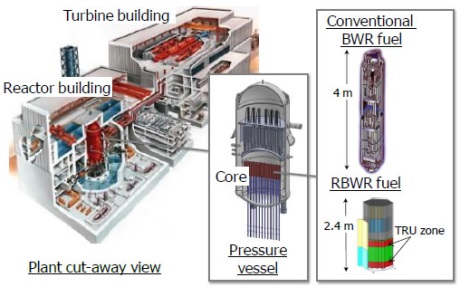It seems to me that the technology behind Nuclear Reactors is evolving as we speak.

|
Column 1 |
Column 2 |
Column 3 |
| 1 |
|
|
|
| | [/table]
[/table]
Technical Evaluation of the Hitachi Resource-Renewable BWR (RBWR) Design Concept
Product ID:1025086
Date Published:30-Apr-2012
Pages:134
Implementation Category:
REFERENCE
Sector Name:Nuclear
Document Type:Technical Results
Implementation Type:
TECHNICAL BASIS
Price:No Charge
This Product is publicly available
5.99 MB - Adobe PDF (.pdf)
Abstract
The capabilities of an advanced Resource-Renewable Boiling Water Reactor (RBWR) developed by Hitachi Ltd. have been analyzed by an Electric Power Research Institute- (EPRI-) organized team from three universities, using largely independent methods.
The analysis has shown that the two variants of the RBWR design that were studied can represent potential alternatives to sodium-cooled fast reactors. The fuel self-sustaining RBWR-AC, which has a breeding ratio slightly greater than 1.0, can be an alternative to the sodium-cooled advanced recycling reactor (ARR), and the RBWR-TB2, which is designed to recycle the transuranic elements (TRU) discharged from the once-through light water reactors (LWRs), can be an alternative to the sodium-cooled advanced burner reactor (ABR). Although not as efficient (neutronically and thermodynamically) as their sodium-cooled alternatives, the RBWR designs have the great advantage of using the well-established light water technology and fitting within the footprint of an advanced BWR (ABWR).
Objective
Evaluation of the RBWR design represented a considerable analytic challenge. The methods available today have not been designed or benchmarked for the analysis of cores as complex as those of the RBWR. The investigators had to develop the needed capability by coupling state-of-the-art neutronics and thermal-hydraulics capabilities to provide an objective simulation of the RBWR-AC and RBWR-TB2 cores.
Approach
The three university teams undertook different aspects of the analysis. The University of Michigan team developed the coupled neutronics and thermal-hydraulics code system and used it to calculate the equilibrium cycle core performance parameters of the RBWR-AC and RBWR-TB2 cores. In addition, this team had the responsibility for combining the other two teams' results into the final report. The University of California, Berkeley team compared the fuel cycle performance of the above two cores to their sodium-cooled alternatives. The Massachusetts Institute of Technology team provided an assessment of fuel performance using an enhanced version of the U.S. Nuclear Regulatory Commission code FRAPCON. This team also contributed work that was done under other funding relating to the evaluation of reactivity coefficients and stability.
Results
The analyses collectively indicate that the two reactors appear to be able to achieve their design objectives: The RBWR-AC provides an equilibrium-cycle breeding ratio of slightly above 1.0, thus providing for a self-sustaining fuel cycle in which depleted uranium is used for the makeup fuel. The RBWR-TB2 is capable of unlimited continuous recycling of TRU while consuming on the order of 10% of the loaded TRU per recycle (after accounting for the newly generated TRU). Most results confirmed the values estimated by Hitachi. Some differences among the predicted reactivity coefficients need to be evaluated further.
Application, Value and Use
The RBWR designs deserve to be considered among the candidates for next-generation reactors. They provide a possibility for more efficient use of our uranium resources (compared to LWRs) and for the near-complete elimination of the long-lived transuranic waste. Since these designs use the well-established light water technology, their commercialization (including licensing) is likely to require a significantly shorter time and smaller investment in research and demonstration than their sodium-cooled alternatives.
The RBWR has been shown to be a very promising concept that should be carried further. However, additional work, including development of more rigorous methods, resolution of the disagreements or challenges identified in our evaluation, safety performance analysis, and support for benchmarking experiments eventually leading to a demonstration plant, can best be carried out under the programs of the U.S. Department of Energy (DOE) for next-generation reactors.
The concepts, including the results of this analysis have been presented to the DOE.
As a result, two RBWR-related projects teaming the above universities with national laboratories have recently been funded under DOE's Nuclear Energy University Program (NEUP). !
$3.95
!
$3.95
 (20min delay)
(20min delay)










